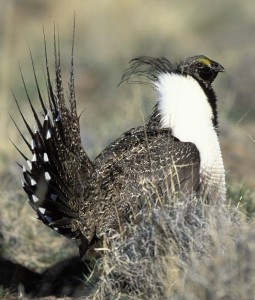My home county (Mesa County) commissioners have decided to join several others in suing the federal government for listing the Gunnison sage grouse as “threatened.” It is the right move. Sometimes the courts are the last resort against bullies.
 The controversy over the bird’s listing is not just ironic (we have been here before but reached an agreement to prevent it). It represents one of the worst broken promises in the history of conservation.
The controversy over the bird’s listing is not just ironic (we have been here before but reached an agreement to prevent it). It represents one of the worst broken promises in the history of conservation.
The Gunnison Ranchlands Legacy project started in the mid-1990s and thrived through the Administrations of four governors of both parties. The State of Colorado in 2005 completed an agreement with the federal government that allowed landowners to enroll in a program of protective habitat management, with the assurance that their farming practices would not get them into trouble if grouse nests are accidentally disturbed. As a result, the species was removed from the “candidate” list, and local participation has surpassed any similar program in the United States. All of this investment and local participation was made with the clear understanding that the species would not be added to the federal endangered list. This program was the alternative to that listing.
Habitat partnerships and management agreements are not unique to Colorado, of course. But no other state/local partnership has ever come close to our level of commitment to such a program. Coloradans have invested well over $50 million of state, local, and private money in conservation easements to preserve ranchlands in the Gunnison Basin, and have preserved over 64,000 acres of open space, ranchlands, and sage grouse habitat. That’s a 20-year legacy, including another $3 million last year, and we are proud of it. Besides preserving the historic character of scenic mountain valleys, it demonstrates that species can be protected without heavy-handed federal regulation, while preserving vital local economies. As a member of the Great Outdoors Colorado board, I strongly supported the program for several years and remain proud of that inheritance for future generations.
Ranchers were understandably skeptical, with one final and difficult question: can we trust the government to do what it says? Without that trust, adding a species to the endangered list can actually harm the species, because its habitat is mostly on private land. Landowners, and the State, relied on that trust for a generation. Today, the Gunnison sage grouse population is strong and growing steadily – it is not in danger of extinction by any measure. Still, some national environmental groups and federal officials simply will not give up the “command-and-control” approach. It is pathetic that decisions of this magnitude are sometimes motivated by lawsuits, not conservation. Yet here we are, faced not only with the listing and the broken promise it represents, but a sad and avoidable end to a proud legacy of conservation efforts in the area. If the goal is to end ranching and stop human activity, the effort will go on endlessly. But if species recovery is the goal, the government is going about it exactly the wrong way.
Perhaps worse, the Fish and Wildlife Service always knew this would lead straight to court. Governor John Hickenlooper was clear that the listing would be “a major blow to voluntary conservation efforts,” and promised “we will do everything we can, including taking the agency to court, to fight this listing…” Then-Senator Mark Udall said the listing “threatens to unravel much of the grassroots and science-based progress Colorado has made…” Senator Michael Bennet added that “Washington should learn from Colorado’s model, not upend it. [The listing] only leaves Southwest Colorado with more uncertainty and conflict as this issue is re-litigated in the courts.”
True to their word, the State, and at least three counties have now filed notices of intent to sue. They have a very strong case, partly because during the last 20 years the federal government never once told state or local officials that their efforts were insufficient, or that the listing could not be avoided. On the contrary, we were always led to believe that these programs would help avoid a listing. As Congressman Scott Tipton has said, “In addition to implementing a wide range of voluntary conservation efforts, these stakeholders have done everything the federal government has asked to ensure the recovery of this species.”
Napoleon once said, “If you wish to be a success in the world, promise everything, deliver nothing.” Surely our government could pick a better role model.
(A version of this column appeared in the Grand Junction Daily Sentinel March 11, 2015)




Comments on this entry are closed.